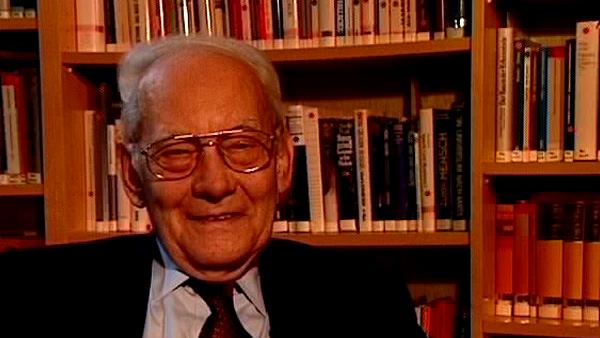NEXT STORY

Differences between the Monod and Koshland mechanisms
RELATED STORIES

NEXT STORY

Differences between the Monod and Koshland mechanisms
RELATED STORIES



Jacques Monod and François Jacob had the idea of allosteric reaction control by enzymes, which meant you can switch on and off the reactivity of an enzyme molecule by binding another ligand. The ligand might be the substrate itself, which in addition bind... it might be the product of the reaction or it might be some other effector. A typical allosteric protein, not an enzyme but you might say enzyme...
[Q] Honoris causa?
... honoris causa is the haemoglobin molecule, that molecule which binds the oxygen and transports it to the places in the organism where it has to be burnt... where the food has to be burnt. So in other words the molecule in the lung, where oxygen comes in, must take up as much as possible oxygen, so it must have a high binding capacity while, when it comes to the cell places where the oxygen has to be given off, it has to have a low affinity to oxygen in order to give it. So you see that is a typical protein in which the control of the reaction plays some role.
Now we, when I say we again it was Kaspar Kirschner, who came from Feodor Lynen, from Munich, to me, is a biochemist, he choose another enzyme, glyceraldehyde phosphate dehydrogenase, and it turned out that this enzyme behaved exactly according to a mechanism which was proposed by Jacques Monod together with Jean-Pierre Changeux and Jeffries Wyman. In 1965, '66 there were several papers on this exciting new field of allosteric enzymes. There was this paper by Monod, Changeux and Wyman, there was another paper by Koshland, and there was our experimental study.
Nobel Prize winning German biophysical chemist, Manfred Eigen (1927-2019), was best known for his work on fast chemical reactions and his development of ways to accurately measure these reactions down to the nearest billionth of a second. He published over 100 papers with topics ranging from hydrogen bridges of nucleic acids to the storage of information in the central nervous system.
Title: The exciting new field of allosteric enzymes
Listeners: Ruthild Winkler-Oswatitch
Ruthild Winkler-Oswatitsch is the eldest daughter of the Austrian physicist Klaus Osatitsch, an internationally renowned expert in gas dynamics, and his wife Hedwig Oswatitsch-Klabinus. She was born in the German university town of Göttingen where her father worked at the Kaiser Wilhelm Institute of Aerodynamics under Ludwig Prandtl. After World War II she was educated in Stockholm, Sweden, where her father was then a research scientist and lecturer at the Royal Institute of Technology.
In 1961 Ruthild Winkler-Oswatitsch enrolled in Chemistry at the Technical University of Vienna where she received her PhD in 1969 with a dissertation on "Fast complex reactions of alkali ions with biological membrane carriers". The experimental work for her thesis was carried out at the Max Planck Institute for Physical Chemistry in Göttingen under Manfred Eigen.
From 1971 to the present Ruthild Winkler-Oswatitsch has been working as a research scientist at the Max Planck Institute in Göttingen in the Department of Chemical Kinetics which is headed by Manfred Eigen. Her interest was first focused on an application of relaxation techniques to the study of fast biological reactions. Thereafter, she engaged in theoretical studies on molecular evolution and developed game models for representing the underlying chemical proceses. Together with Manfred Eigen she wrote the widely noted book, "Laws of the Game" (Alfred A. Knopf Inc. 1981 and Princeton University Press, 1993). Her more recent studies were concerned with comparative sequence analysis of nucleic acids in order to find out the age of the genetic code and the time course of the early evolution of life. For the last decade she has been successfully establishing industrial applications in the field of evolutionary biotechnology.
Tags: allosteric reaction control, haemoglobin molecule, glyceraldehyde phosphate dehydrogenase, allosteric enzymes, Jacques Lucien Monod, François Jacob, Kasper Kirschner, Feodor Felix Konrad Lynen, Jean-Pierre Changeux, Jeffries Wyman, Daniel Edward Koshland Jr
Duration: 2 minutes, 29 seconds
Date story recorded: July 1997
Date story went live: 24 January 2008